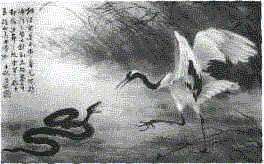THE IMPORTANCE OF THE WAIST
Yang Chang-Fuís "10 Essential Points" state in part:
Point 3 Loosen (relax) waist:
The waist is the key to, or commander of, the body. If you can loosen the waist, then your legs will have power and your body will be firm and stable. The change from substantial to insubstantial (solid to empty) is controlled by the waist. It is said, "the source of the posture lies in the waist. If you cannot obtain power, seek the defect in the legs and waist."
Point 7 Co-ordinate the upper and lower body movements.
The Taijiquan classics say, "motion should be rooted in the feet, released through the legs, controlled by the waist, and manifested by the hands through the shoulders and arms". The whole body should act as one integrated unit. Thus when your hands move, your waist and feet as well as the focus of the eyes must move accordingly. Whenever there is any lack of co-ordination the movement instantly will appear disjointed and will lack strength.
Further, "the song of Thirteen Postures" (by an unknown author) begins:
"Never neglect any of the 13 postures...."
The source of the will is in the waist.
Pay attention to the slightest change from full to empty
Let the chi flow through whole body constantly
Stillness embodies motion, motion stillness
Seek stillness in motion
Surprising things will happen when you meet your opponent
Give awareness and purpose to every movement
When done correctly all will appear effortless
At all times pay attention to the waist.......
Why is the waist so important that it is a continually recurring theme in Taijiquan?
Consider a sphere or preferably a round ball.

top
The ball will react to any
external force applied to it by absorbing that force in full or part and
moving in the same direction as the force or at an angle from the point of
impact. However, the equilibrium (or balance) of the ball can never be
upset. Why?
At all times the centre of ball is and remains perpendicular to the floor.
In our training, we should strive always to imitate the action of the ball. How? Why? What is the relevance of the ball to the waist?
I will try to explain.
Every person who begins instruction in Taijiquan is first taught the 6 basic
exercises. These exercises represent the foundation of Taijiquan practice and seek to introduce several essential elements:
correct posture
basic qigong
increased leg strength
From these basic exercises come the forms. The beginning form seeks to align the body and keep it straight in accordance with the natural laws and the laws of physics as expressed in the basic principles found in Yang Chang-Fuís 10 essential points.
Top
In performing the beginning
movement, the practitioner is taught to sink down to a comfortable height
and to maintain that height throughout the forms. When moving backwards,
forwards, to the side and turning we are taught always to maintain both
beginning height and vertical alignment of the body.
Many of you would have heard me speak of imagining a steel rod passing from the ceiling through top of head and down through the body to the floor. The purpose of this imagery is to assist in keeping the body straight and in correct alignment and therefore has a similar purpose to the image of the ball being discussed.
A further basic concept continually discussed is the dantien, located about three finger widths below the navel and internally. This point, the dantien, is considered to be the centre of the body, if you like - the bodyís centre of gravity.
Therefore, if you imagine this area of the body, ie. the area of the waist/hips/pelvic girdle, as containing the ball, then the centre of the ball corresponds to the centre of the body, the dantien.
Thus, to enable us to maintain our equilibrium (balance) regardless of the extent and direction of any external force applied, ie. The severity and direction of an attack, we should strive always to imitate the ball by keeping our centre perpendicular to the floor.
This is known as maintaining your centre, or being centred.
A further point which I would like to stress is the importance of leg strength as a pre-requisite to improvement. It is particularly difficult to apply the basic principles during practice, ie. shoulders relaxed and down, head up, deep slow rhythmic breathing, loose, relaxed nimble movements etc, if the mind is distracted by aching, trembling and protesting leg muscles.
Remember the closing sentence in point 3 of the 10 essential points:
"If you cannot obtain power, seek the defect in the legs and waist."
In closing, one of the most puzzling aspects I have found in trying to read about and understand Taijiquan is the rather colourful and obscure language used by the early masters to describe its origin, purpose and techniques. Undoubtedly, cultural differences and difficulties in translation are a prime consideration (particularly for western students). However, these aspects can be overcome if we keep in mind several important point
Taijiquan is a martial art, a fighting art.
Therefore, many of the basic principles as expressed in Yang Chang-Fuís 10 essential points, are principally aimed at training the student to use the body in a flexible/balanced/nimble way in order to apply offensive and defensive actions and reactions in fighting. Further, in days past when people were perhaps not as well educated as we are today, most teachings were verbal and to aid retention were often expressed in song, poem and rhyming verse which people were more easily able to memorise and pass on to others.
If you keep these points in mind, then a lot of the mysticism surrounding taijiquan can be lifted and real meaning and purpose behind Taijiquan principles can be better understood.

IAN ETCELL